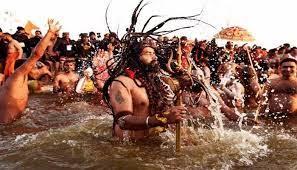The Kumbha Mela is a sacred Hindu pilgrimage festival that takes place every twelve years in India. It is considered to be one of the largest religious gatherings in the world, with millions of devotees converging on the banks of the Ganges, Yamuna, and Saraswati rivers to take a holy dip in the water.
The origin of the Kumbha Mela can be traced back to ancient Hindu mythology. According to the legend, during the Samudra Manthan or the churning of the ocean by the Devas (gods) and Asuras (demons), a pot or Kumbha containing the elixir of immortality (Amrita) emerged from the depths of the ocean. The Devas and Asuras fought for the pot of elixir, and during the ensuing battle, drops of the elixir fell on four locations on earth- Prayagraj (Allahabad), Haridwar, Nashik, and Ujjain.
These four locations are believed to be the sites where the Kumbha Mela takes place every twelve years. The festival rotates between the four cities, with each city hosting the festival once every twelve years. The Kumbha Mela in Prayagraj is known as the Maha Kumbh Mela and is considered to be the most significant of all the Kumbha Melas.
The first historical evidence of the Kumbha Mela can be found in the accounts of Chinese traveler Xuanzang, who visited India during the reign of Emperor Harsha in the 7th century CE. Xuanzang wrote about a festival that took place every twelve years at Prayagraj, where millions of people gathered to take a holy dip in the Ganges river.
The Kumbha Mela gained more prominence during the Mughal era, when Emperor Akbar visited the festival in 1575. Akbar was impressed by the scale of the festival and the devotion of the pilgrims, and he gave the festival his royal patronage. The Kumbha Mela continued to grow in size and importance over the centuries, and it is now recognized as a major cultural and religious event in India.

The Kumbha Mela is a symbol of Hindu unity, as it brings together people from all walks of life and different castes and communities. It is also an opportunity for spiritual seekers to come together and exchange ideas and experiences. The festival is a celebration of India's rich cultural and spiritual heritage, showcasing the diversity and complexity of Hinduism.
The rituals and ceremonies associated with the Kumbha Mela are integral to the festival. The main event is the holy dip or Shahi Snan, which takes place on specific auspicious dates according to the Hindu calendar. The Shahi Snan is considered a purification ritual. It is believed that taking a dip in the holy water of the Ganges, Yamuna, and Saraswati rivers during the Kumbha Mela can wash away sins and grant spiritual liberation.
Apart from the holy dip, the Kumbha Mela also features numerous religious and cultural events, including discourses by spiritual leaders, performances of music and dance, and exhibitions of traditional crafts and arts. The festival also attracts many Sadhus (ascetics) and Naga Sadhus (naked ascetics), who come to the festival to perform their own rituals and display their spiritual prowess.
In recent times, the Kumbha Mela has faced several challenges, including issues related to sanitation, crowd management, and security. However, the festival continues to thrive and evolve, and efforts are being made to address these challenges and make the festival more accessible and inclusive.